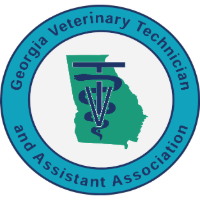Veterinary Assistant Resources
How To Become A Veterinary Assistant:
Enroll in a Veterinary Assistant Program
Online programs include: Animal Behavior College, Georgia Southern University, Penn Foster, University of Georgia, University of North Georgia, VetBloom, and VetMedTeam
Jump in.
Many clinics are willing and happy to train a veterinary assistant candidate on the job, some may even assist with the cost of attending a Veterinary Assistant program.
Veterinary Assistant Supervision and Responsibilities
-
(1) Immediate Supervision means that the duly licensed veterinarian is in audible and visual range of the animal patient and the person treating the animal.
(a) A duly licensed veterinarian is responsible to assure that the following tasks being performed by Veterinary Assistants is under immediate supervision:
Surgical assistance;
Maintenance of anesthesia;
Application of splints and slings;
Dental extractions not requiring sectioning of the tooth or the resectioning of bone;
Euthanasia;
Blood or blood componenet collection and preparation for transfusion;
Administration and application of treatments, drugs, medications, and immunological agents by IV routes;
Collection of urine by cystocentesis or catherization; and
Administration of blood or blood components to animal patients.
-
(1) Direct supervision means that the duly licensed veterinarian is on the premises and is quickly and easily available and that the animal patient has been examined by a duly licensed veterinarian at such time as acceptable veterinary medical practice requires, consistent with the particular delegated animal health care task
(a) A licensed veterinarian is responsible to assure that the following tasks being performed by Veterinary Assistants is under direct supervision:
Intravenous catheterizations,
Collection of blood for diagnostic purposes; collection of feces: collection of urine by expression; collection and preparation of tissue, cellular, or microbiological samples by skin scrapings, impressions, or other non-surgical methods for diagnostic purposes;
Dental procedures including, but not limited to the removal of calculus, soft deposits, plaque and stains; the smoothing, filing, and polishing of teeth; or the floatation or dressing of equine teeth;
Routine laboratory test procedures;
Radiology assistance including setting, positioning, processing and safety procedures;
Assisting any duly licensed veterinarian in the measuring of quantities of medication, but excluding the dispensing, compounding, or mixing of drugs; and
Initiation of parenteral fluid administration.
-
(1) Indirect supervision means the duly licensed veterinarian is not on the premises but has given either written or oral instructions for the treatment of the animal patient and the animal has been examined by a duly licensed veterinarian at such times as acceptable veterinary medical practice requires, consistent with the particular delegated health care task.
(a) A duly licensed veterinarian is responsible to assure that the following tasks being performed by Veterinary Assistants is under indirect supervision:
Administration and application of treatments, drugs, medications and immunological agents by oral, IM subcutaneous routes excluding rabies vaccine for animals required to receive a rabies vaccine by Georgia law;
Grooming procedures and non-invasive skin (topical) treatment;
Handling of biohazardous waste materials.
(2) A veterinary assistant working under the direction, supervision and control of a duly licensed veterinarian may provide the following emergency animal patient care under indirect supervision.
(a) Application of tourniquets and/or pressure bandages to control hemorrhage;
(b) Resuscitative procedures;
(c) Application of temporary splints or bandages to prevent further injury to bones or soft tissues;
(d) Application of appropriate wound dressings and external supportive treatment in severe wound and burn cases; and
(e) External supportive treatment in heat prostration cases.
-
(1) Nothing in this chapter shall be construed to permit Veterinary Assistants to do the following:
(a) Make any diagnosis or prognosis;
(b) Prescribe any treatments, drugs, medications, or appliances;
(c) Perform surgery.
(d) Perform a nonemergency intubation;
(e) Induce anesthesia;
(f) Perform central venous catherization;
(g) Perform arterial catherization;
(h) Arterial collection for any animal;
(i) Administer a rabies vaccine to an official vaccinate; and
(j) Identify himself/herself as a Veterinarian Technician.
What’s an Approved Veterinary Assistant?
The designation of “Approved Veterinary Assistant” was created by the National Association of Veterinary Technicians in America (NAVTA) in recognition of the contributions veterinary assistants make to the practice team and to the health of pets.
Interested in Becoming a Licensed Veterinary Technician?
Find the AVMA-CVTEA Accredited Program that fits you:
Conquer the Veterinary Technology National Exam (VTNE)
-
-
-AAVSB offers practice exams (https://www.aavsb.org/vtne-overview/study-for-the-vtne)
-VetTechPrep.com (https://www.vettechprep.com/)
-PocketPrep.com (https://www.pocketprep.com/exams/aavsb-vtne/)
-Mosby's Comprehensive Review for Veterinary Technicians (wherever most books are sold)
Apply for your License & Settle into Your New Career
We want to hear your stories!
Are you a veterinary assistant? Would you like to show off your career, your team, and yourself? We would love to spotlight your story, a day in your work-life, and more! Please contact us through the Contact Us Form, or through our Facebook or Instagram. We can’t wait to hear from you!






